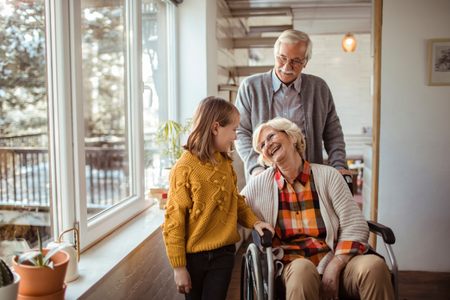
For many people, the idea of aging in place is appealing. The ability to stay in one’s own home as you age has numerous benefits. It can provide a sense of continuity and comfort, as well as increased independence and control over one’s environment. Plus, aging in place can often be less expensive than moving to a retirement community or long-term care facility. It also allows people to remain close to their family and friends, which can be especially beneficial as they age.
This style of living can allow people to age with dignity, in a setting that is familiar and comfortable to them. For all these reasons, aging in place is an attractive option for many seniors. As a result, we may find ourselves in the position of needing to make some changes to our homes to make them more accessible. This can be a challenge, but it’s important to do what we can to help our aging parents stay safe and independent. Here are a few tips on how to make your home more accessible for aging parents.
6 Ways to Make Your Home Accessible for Aging Parents
As people age, they often find that their homes are no longer as accessible as they once were. Stairs become more difficult to navigate, and small bathrooms can be challenging to use. If you have aging parents who are struggling to live independently, there are a few modifications you can make to your home to make daily routines easier.
1. Outdoors: Add Lighting
One way to make your home more accessible for aging parents is to add lighting to the outdoor spaces. This will help them see when they are coming up to the door, and it will also help prevent falls. Make sure all surfaces are non-slip.
Consider adding motion-sensor lights that will turn on when they walk up, and make sure there is a light over the door so they can easily find the keyhole. You may also want to add a ramp or set of stairs with a handrail, depending on what is needed.
2. Living Room: Make Modifications to Prevent Falls
Another important area to focus on is the living room. This is typically the main gathering space in the home, and it’s where your parents will spend a lot of their time. To prevent falls, make sure there is plenty of light and that all rugs are firmly anchored to the floor.
Remove any tripping hazards, such as coffee tables with sharp corners or cords that run across the floor. You may also want to install grab bars near chairs and sofas to provide extra support when getting up.
You might also consider rearranging furniture to clear pathways and create more open space.
3. Bedroom: Consider a Move
One way to make your home more accessible for aging parents is to consider moving the bedroom downstairs. This will help them avoid having to use the stairs, which can be difficult or even dangerous for someone who is elderly or mobility impaired.
Don’t think a move downstairs is possible – or practical? A stairlift can be a great way to make your home more accessible for seniors.
A stairlift is a chair that attaches to the stairs and allows the user to ride up and down the stairs with ease. This can make a big difference for seniors who live in multi-story homes. A stairlift can also be a great way to provide independence for seniors who may otherwise have to rely on others for help getting around their own homes.
Think a stairlift is too expensive? The average stairlift cost might surprise you, so do some research.
4. Bathroom: Tackle the Basics
As people age, they may start to have difficulty with activities that were once easy, such as bathing. There are several ways to make a bathroom more accessible for aging parents, including installing grab bars, a shower seat, and a handheld showerhead.
Grab bars can provide support when getting in and out of the tub or shower, and a shower seat can offer a place to rest when showering. A handheld showerhead can be mounted at a lower height, making it easier to reach. In addition, non-slip flooring can help prevent falls.
5. Kitchen: Lower It Down
One common modification is to install grab bars near the sink and stove. These grab bars provide stability and support when you are standing or sitting, making it easier to complete kitchen tasks. Another modification is to lower the height of cabinets and shelves. This way, you won’t have to reach as high or strain your back when trying to access items in the kitchen.
6. Entryway: Add Accessibility Upgrades
Another way to make your home more accessible is to widen the doorways. This will give them more room to maneuver, and it will also allow them to use a wheelchair or walker if necessary. You can either have the doorways widened by a professional, or you can install new doors that are wider than the existing ones. If you go with new doors, make sure they are designed to be easy to open and close. You may also want to add a ramp going into the home from all entrances and exits to make the home safer in the event of an emergency.
Age in Place with Accessibility Upgrades
Many people find themselves in the position of caring for aging parents. As our loved ones age, they may need help with everyday tasks such as cooking, cleaning, and bathing. In some cases, they may also need assistance with more personal matters. While this can be a difficult role to take on, there are ways to make it easier.
Aging parents can face many challenges, but with a little preparation and some simple changes, you can make your home more accessible and welcoming.
